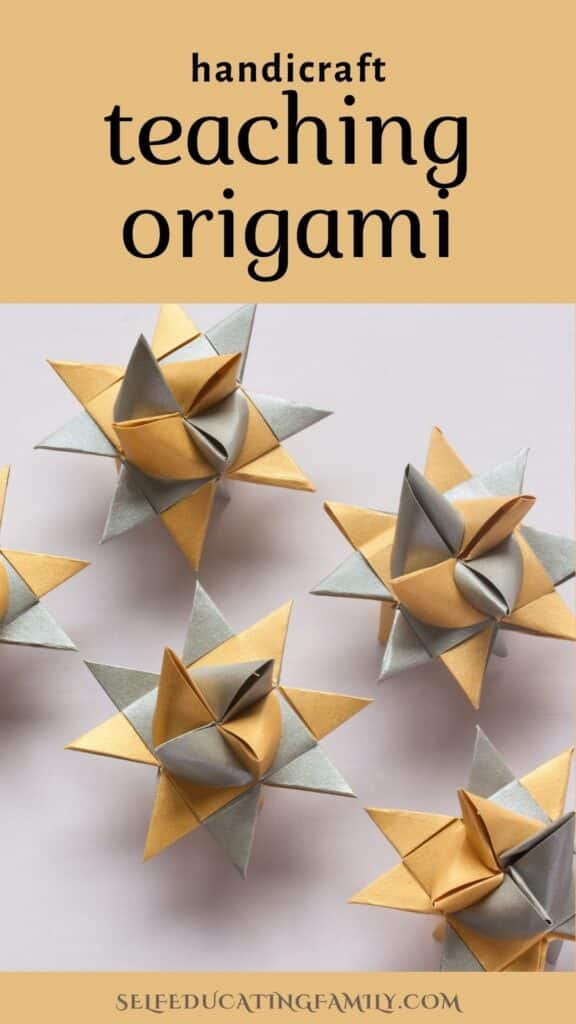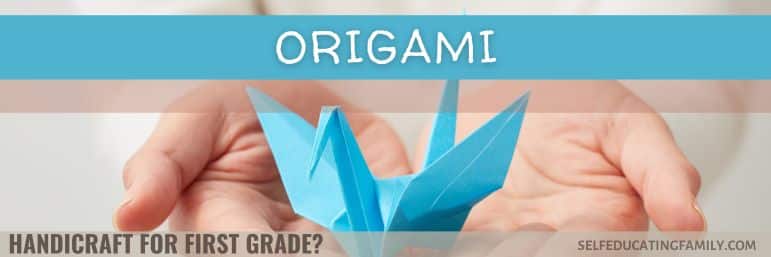What’s inside: Today, we look at origami, the art of paper folding and show why it is a fantastic choice for your youngest students as they begin handicraft.
This post may contain affiliate links. If you find my content valuable and make a purchase through one of my links, I will earn a commission at no cost to you, which helps me keep this blog going so I can help you even more! I recommend products I trust and/or use myself, and all opinions I express are my own. Read the full disclaimer here.
Background
If you don’t know how Paper Sloyd developed in the Charlotte Mason (CM) schools, you may want to familiarize yourself before you read this post.
Basically, little kids don’t have the eye-hand coordination required to cut straight lines with ruler and knife (x-acto blades) and so the schools turned to paper folding (origami) for first graders – which were known as Form 1B in CM schools.
How does this help us today?
Principles of Sloyd as applied to Handicraft
In our earlier discussion, we need to keep the following Sloyd principles in mind:
- Stay within the child’s compass.
- Start simple and build skills.
- Child does all the work.
- Challenging, but not too challenging.
- Have the child evaluate their own work.
- Make sure they aren’t being too perfectionist, but that they are doing it correctly and to their satisfaction.
- Work carefully with complete focus.
- No slipshod work.
Why Origami?
Paper folding, also known as origami, is a great handicraft for first graders.
Why?
Because they don’t have to cut a perfect square which is necessary for paper modeling.
Paper modeling starts with rulers and model patterns and knife blades to make three dimensional models.
Origami starts with pre-cut paper squares.
- Origami starts with perfect squares, but if you had to cut your own, the model may be misshapen. Cutting perfect squares is generally out of reach for first graders.
- Note: If you have a gifted child who loves cutting, you can test their perfect square cutting ability. Using a ruler and triangle, have them measure and cut a 5” square. Have them test it for squareness by folding on the diagonal in both directions. It should line up exactly.
- It would be unusual if your child can do this after kindergarten. But children are persons!
- Folding becomes the skill they are perfecting. Lining up corners and sides, making clean creases – these are skills they build starting with the simplest models. Then following the instructions is another skill they are working on – learning to read model diagrams.
- The pre-cut paper is sized for little hands and comes in delightful colors and/or patterns.
- This stirs the imagination.
Paper Folding: Origami Handicraft for Grade 1
How can we start?
So we see that with handicraft, we need to keep within the bounds of the child’s ability. You want the child to be ABLE to complete the work “perfectly” – Charlotte Mason calls this perfect execution. So you must build the child’s skills all the while keeping within the child’s abilities.
What if we accidentally choose a model and didn’t realize it was too hard?
No worries. Assist as needed and move along. Give yourself space to find the proper level of difficulty. Especially when learning a new handicraft. As the child gains proficiency, you will teach them to fairly critique their own work. The whole thing is a process and the emphasis is not on the “perfect outcome” but rather on the skills learned. They may want to try making a model a second time. Use your judgement.
Applications to Origami with young learners
The idea of perfect execution and paper folding is a great example. Charlotte Mason adjusted the curriculum at her schools in order to find balance, as did Brittany McCann in her homeschool (as discussed in the article at Charlotte Mason Poetry). Brittany studied Sloyd techniques with her children. Both she and Charlotte Mason discovered that Form 1B (first grade) students were too young to successfully cut squares with the precision needed for paper folding.
Does that mean they shouldn’t try? No. Try.
But then go ahead and work on paper folding. The eye-hand coordination will develop.
With origami, you provide the child with origami paper, which is already a perfect square. When they can reliably fold the square into a triangle with all edges aligned, they may be almost ready to cut the perfect square – if they are accurate with their scissors.
Scissor cutting can be practiced on scraps or on non-critical paper – like wrapping paper.
I read one Origami book in which one of the first projects was cutting a perfect square. I think it was written before Origami became popular and you could buy paper just for the craft.
I really like the book, and I think you can move forward in both directions.
Our experience with Origami
When we approached origami as handicraft, my kids were older than first grade. We were in a co-op and had a nice range of ages, but we dived in with more complicated models after we spent a week on napkin folding, which was fun for everyone.
We were inspired to select origami as a handicraft one semester after we read the fun read-aloud book on tape as a family called “Origami Yoda”. We then had to take the book out of the library because we found out it had directions for making the models in the book. It’s an easy, fun, middle school aged book. I’m not sure it qualifies as a living book, but my family enjoyed it anyway.
We were Star Wars fans and that was the draw.
So we made Star Wars character origami models.
All in all, our experience was very favorable and anytime I want someone to make a jumping frog (not a Star Wars character, in case you are not a fan), they can still do it.
Incidentally, if your children are older, they still have to learn the basics, and go through the same sequence of skills. They will just be much faster at it than a first grader.
Recommended books
- The Art of Chinese Paper Folding for Young and Old by Maying Hsi Soong. Great book to use as a complete curriculum. Select a few models for your youngest kids, and let older kids go through as many as they like, as long as they are working carefully!
- The Strange Case of Origami Yoda by Tom Angleberger.
- Paper Modelling by M. Swannell. This is a revised copy of a book used in CM schools for form 1B (approximately). The models are copied and then cut and folded.
- Paper Sloyd: A Handbook for Primary Grades (Yesterday’s Classics) by Ednah Anne Rich. Also used in CM schools. To make the models in this book, you need a ruler to measure then make the models.
Related Posts

FAQ
Paper folding is also called the art of Origami.
Origami engages the mind and body while improving eye-hand coordination and fine motor skills. It also improves the habit of attention and concentration







